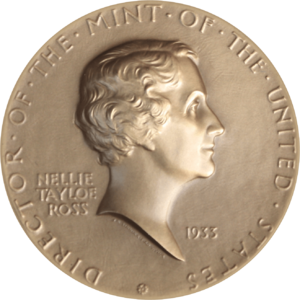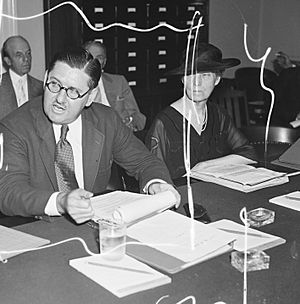Mary Margaret O'Reilly facts for kids
Quick facts for kids
Mary Margaret O'Reilly
|
|
|---|---|
 |
|
| 1st Assistant Director of the United States Bureau of the Mint | |
| In office July 1, 1924 – October 29, 1938 |
|
| President | |
| Mint Director |
|
| Succeeded by | F. Leland Howard |
| Personal details | |
| Born | October 14, 1865 Springfield, Massachusetts, U.S. |
| Died | December 6, 1949 (aged 84) Washington, D.C., U.S. |
Mary Margaret O'Reilly (born October 14, 1865 – died December 6, 1949) was an important American government worker. She served as the Assistant Director of the U.S. Bureau of the Mint from 1924 to 1938. She was one of the highest-ranking women in the U.S. government during her time. Mary worked at the Mint for 34 years. She often took charge as acting director when the main Mint Director was away.
O'Reilly was born in Springfield, Massachusetts. Her family had moved there from Ireland. When she was about 14, she left school to help her widowed mother and siblings. She likely worked in local textile mills. She also went to night school to learn office skills. After that, she worked as a clerk in Worcester for 18 years.
In 1904, O'Reilly got a job at the Mint Bureau. This meant she moved to Washington, D.C. She quickly moved up in the bureau's ranks. This was very unusual for a woman back then. She often spoke to the U.S. Congress. Many Mint directors were chosen for political reasons. They often knew little about how the Mint worked. So, Mary O'Reilly often ended up running things. In 1924, she was officially named Assistant Director.
In 1933, the Mint got its first female Director, Nellie Tayloe Ross. At first, Mary and Nellie didn't trust each other. But they soon became good friends. Mary was supposed to retire in 1935. However, President Franklin D. Roosevelt thought she was too important. He delayed her retirement until 1938. After retiring, Mary stayed in Washington D.C. She didn't work for the Mint anymore. Instead, she spent her time helping Catholic charities.
Contents
Early Life and First Jobs
Mary Margaret O'Reilly was born in Springfield, Massachusetts, on October 14, 1865. Her parents, James and Joanna O'Reilly, came from Ireland. Mary was one of five children. The family lived in Springfield and nearby Chicopee, Massachusetts. Her father, James O'Reilly, sold liquor. He passed away in 1873 after an illness.
Mary left school after the ninth grade. She was about 14 years old. She needed to help her family earn money. She probably worked in one of the local textile mills. She also went to night school. There she learned how to be a clerk and a stenographer. From 1885 to 1903, she worked as a clerk. She lived in Worcester with her brother. They stayed in a boarding house owned by their mother.
Working at the U.S. Mint (1904–1938)
Moving Up in Her Career
Mary O'Reilly started working at the U.S. Bureau of the Mint in 1904. She was 38 years old, older than most new hires. She worked in the main office in Washington, D.C. The Mint Director, George E. Roberts, was very impressed with her skills.
At first, her job was temporary. But in 1905, she became a permanent employee. She was promoted again that same year. She became a Clerk Class I with a good salary. In 1911, she became an adjuster of accounts. This meant she was like the chief clerk of the Mint Bureau. She was in charge of checking all contracts. It was very rare for a woman to rise so high in a male-dominated workplace.
During the 1910s, O'Reilly kept getting promoted. She worked as an examiner and a bullion computer. She often had to speak to Congress. In 1915, Robert W. Woolley became Mint Director. Mary O'Reilly seemed to like him the most of all the directors. She often ended her work notes with friendly wishes. He did the same for her. When Woolley left in 1916, O'Reilly served as acting director for a short time.
Becoming Assistant Director
Most Mint directors in the early 1900s were chosen for political reasons. They often had no experience with the Mint. For example, Director Friedrich Johannes Hugo von Engelken left almost all the work to O'Reilly. This was during his six months as director in 1916 and 1917. The Mint stopped making special "proof coins" in 1916. These coins were popular with collectors. O'Reilly signed many letters about this change. So, some collectors blamed her for it.
When von Engelken left in 1917, Raymond T. Baker became director. He believed more women would get high government jobs. He gave O'Reilly a bigger public role. Each year, Baker spoke to Congress about the Mint's budget. O'Reilly would sit right behind him. In 1920 and 1921, Baker tried to get Congress to officially name O'Reilly as Assistant Director. But he didn't succeed then.
After a new president took office, Frank E. Scobey became director in 1922. He wasn't very interested in Mint work. So, O'Reilly managed most of the bureau's daily tasks. She was the main person to speak to Congress in 1922. She defended the budget and pushed for her Assistant Director title. This time, Congress agreed. She officially became Assistant Director in 1924.
In December 1921, there was a problem with the new Peace dollar coin. The coin's designer had put a broken sword on the back. He meant it to show the end of war. But many people thought it meant disgrace. This made many people angry after World War I. The director was away. O'Reilly realized the sword had to be removed. She got approval from a Treasury official. The Mint's Chief Engraver quickly removed the sword from the coin designs.
O'Reilly managed most Mint operations under Scobey and the next director, Robert J. Grant. The Mint was very busy in the 1920s. O'Reilly watched coinage operations closely. For example, in 1931, she noticed the San Francisco Mint had made very few nickels. She worried collectors would hoard them. She told the mint to make only nickels for the rest of the year. This resulted in more nickels being made.
Working with President Roosevelt and Retirement
In 1933, Franklin D. Roosevelt became president. O'Reilly was serving as acting director when he took office. President Roosevelt appointed Nellie Tayloe Ross as Mint Director. She was the first woman to hold that job. O'Reilly was 67 years old then. She looked like a small, kind grandmother. But she was very strong and determined.

At first, Ross and O'Reilly were unsure about each other. Ross didn't trust career staff. O'Reilly saw another political appointee with no Mint experience. But soon, they learned to respect each other.
One big issue in 1933 and 1934 was collecting most gold coins. O'Reilly sent out a memo about this. She noted that the Federal Reserve Bank could not accept all types of gold. At that time, the Mint Bureau was not a very important part of the Treasury Department.
Ross and O'Reilly soon divided their work. Ross handled public events and big decisions. O'Reilly managed the daily business of the bureau. Ross traveled a lot. She visited Mint facilities and gave speeches. This meant O'Reilly often ran the Washington office as acting director. The two women wrote friendly letters to each other. O'Reilly told Ross she wanted her to feel at ease about the office. She sent frequent telegrams to keep Ross updated.
In 1935, O'Reilly reached the age of 70. This was the mandatory federal retirement age. But her knowledge was so important that President Roosevelt made a special order. He allowed her to work an extra year. This was at Ross's request. Roosevelt approved another extension in 1936. This was a big honor. The Treasury Secretary even held a lunch for her. Roosevelt extended her service again in late 1937. But he warned it would be the last time. She retired on October 29, 1938.
O'Reilly did not want a retirement ceremony. But her co-workers bought her a diamond watch. President Roosevelt and the Treasury Secretary sent letters thanking her for her service. The New York Times newspaper reported her retirement. They wrote that she showed what women could achieve.
Retirement and Later Life
After retiring, Mary O'Reilly continued to live in Washington. She did not get involved in Mint affairs anymore. She kept busy by helping to raise money for Catholic charities.
Mary O'Reilly passed away on December 6, 1949, in Washington.
Images for kids




